|
THE FIRST TRULY
HEAT-TOLERANT GERANIUMS IN THE WORLD

Geraniums in Ohio in Oct., '07 |

Geraniums look good in the Ohio snow!! Dec., 2007 |
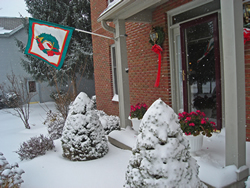
Lynn Parsons are hard on his 'Violet' geraniums, leaving
them in the snow in Bellefontaine, Ohio, in Dec., '07 |
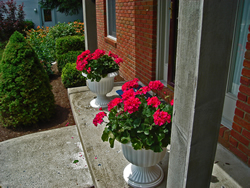
Fantasia 'Violet' geraniums do well at Lynn Parsons' home
in Ohio on June, 2007. |
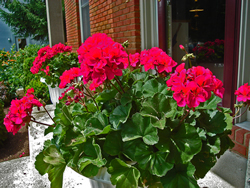
Fantasia 'Violet' geraniums do well at Lynn Parsons' home
in Ohio on June, 2007. |
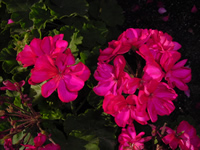
Fantasia Violet Geranium 2 in fall |
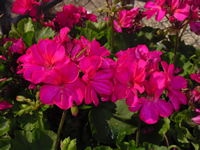
Fantasia Violet Geranium in fall, 2005 |
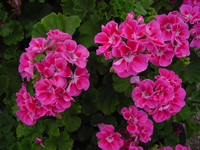
Fantasia Strawberry Sizzle |
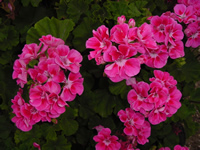
Fantasia Strawberry Sizzle Geranium |
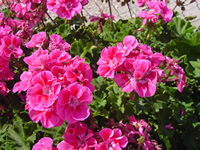
Fantasia Strawberry Sizzle in fall, 2005 |
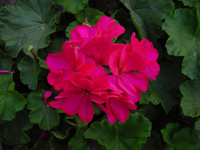
Fantasia Violet Geranium |

Strawberry Sizzle in hanging baskets
|

The Violet geranium compared to a pink geranium in a hanging
basket. |

Violet geraniums in hanging baskets.
|
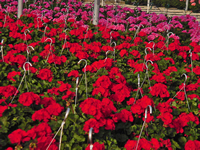
This standard colored geranium might look showier than the
Strawberry Sizzle in the background but when summer comes,
ONLY THE
STRAWBERRY SIZZLE will survive. |

This 90-plus year old Tennessee lady LOVES her Strawberry
Sizzle
geraniums at each side of her door.
|
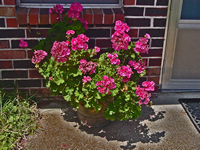
Even in the middle of the summer when other geraniums have
fizzled
in Tennessee, Strawberry Sizzle looks good. |

Any of the Fantasia geraniums do well at Lynn Parsons' home
in
Ohio. |
I used to HATE geraniums. I thought they were the biggest
public rip-off that a plant could be. People purchased them in
the
early spring when those big beautiful blooms were prolific and
enjoyed
them for several months until the heat of late spring or early
summer
arrived. Sometimes in Texas, "spring" only lasts for
a couple of weeks
before the HELL of summer arrives. After the heat starts, the
geraniums
look terrible and even bloom less!! People try to nurse them through
until the cool of fall revives them but sometimes the plants just
die.
That has all changed with the introduction of several new geranium
selections -- the 'Violet' and 'Strawberry sizzle' geraniums from
Ball
Flora Horticultural Company's Fantasia series.
The 'Violet' and 'Strawberry Sizzle' geraniums produce attractive
and
colorful flowers on the most heat tolerant geranium plants EVER
grown in
Texas. During two years ('05) and ('06) of testing, these two
geranium
varieties actually grew and thrived growing in direct sunlight
during
the hottest summers in San Antonio history. Big blooms and durable,
dark
foliage show off the healthiest appearance through the hottest
conditions. This was also confirmed in Tennessee and Ohio tests
in '06.
These new Zonal geraniums are available in 11 colors including
Cardinal Red Improved, Coral Improved, Flame Improved, Flamingo
Rose
Improved, Neon Rose, Pink Shell, Salmon, Shocking Pink, Strawberry
Sizzle, Violet, and White BUT THE MOST HEAT-TOLERANT during both
summers were Strawberry Sizzle and Violet.
Geraniums are usually classified as a 'short-lived perennial,'
which
means they typically live for more than a single year but these
two
varieties may merit a "perennial" classification in
South Texas since
they do well in summer and winter.
You can use these geraniums in beds and borders. A wide range
of colors
is available to complement virtually any color scheme you desire.
In
southern California (and now maybe in South Texas!), geraniums
are used
as a colorful groundcover on slopes and lawns. They are excellent
in
containers of all types from small pots to large tubs to window
boxes
and combine well with other plants such as petunias and ivies.
Geraniums
are one of your best bets for use in hanging baskets.
=====================================================
Common Geranium, Garden Geranium, Zonal Geranium
Scientific Name: Pelargonium hortorum L.H. Bailey
Family: Geraniaceae
Common Geranium, Garden Geranium, Zonal Geranium (Pelargonium
hortorum)
(P. x domesticum, largely derived from P. cucullatum, P. angulosum,
and
P. grandiflorum) have large pansylike flowers, few to the cluster.
Zonal, house, or bedding geraniums (P. x hortorum, a complex
hybrid
largely derived from P. inguinans and P. zonale) are the familiar
forms
in garden culture and in pots indoors. These species were introduced
into Europe in the early 18th century and hybridizers have been
busy
creating stunning new varieties ever since.
Frost Tolerance: Hardy in San Antonio
Heat Tolerance: Better considered as a cool season annual in
San
Antonio UNLESS Strawberry Sizzle and Violet varieties are used.
Sun Exposure: Light shade in summer in San Antonio UNLESS Strawberry
Sizzle and Violet varieties are used-- then
they can be planted in full sun
Origin: South Africa
Growth Habits: Shrubby perennials generally grown as tender annuals,
up
to 3 feet tall (45 cm)
Plant in ordinary well-drained soil. Plants grown in containers
like to
be rootbound. Over-fertilization may result in excessive foliage
and few
flowers. When fertilizing, use Osmocote Slow-Release Fertilizer
pellets
for containers and use a NON-weed-and-feed Slow-release fertilizer
such
as 19-5-9 for beds.
Moisture: Keep soil moist during hot weather. Allow to dry between
waterings during cool periods. Constantly wet soil will quickly
rot
roots. Treat with a terrachlor (Turficide) product if rots occur.
Use
Daconil Fungicide for foliage disease if spots appear on the leaves.
Hardiness: USDA Zones 8 - 10. The geranium hybrids are tender
perennials. They are grown as annuals in cooler zones. Plants
can be dug
and potted and brought inside for the winter. Some gardeners prefer
to
dig the plants and remove all of the soil from the roots. The
roots are
wrapped in newspaper and the plants placed in a cool dry place
until
spring.
Propagation: Geraniums can be grown from cuttings. For more
information about how to propagate geraniums from cuttings, see:
http://elkhorn.unl.edu/epublic/live/g190/build/#propagation and:
To propagate geraniums from cuttings, first select containers
3 to 4
inches deep and fill them with moist (not overly wet) planting
medium.
Satisfactory rooting media include coarse sand, perlite, vermiculite
or
a mixture of these. Sterile commercial mixes are also available.
Cut off
shoot tips 3 to 5 inches in length and remove the leaves on the
lower
part of the stem. The use of a rooting hormone is recommended
to
stimulate the rooting process. This product is available at most
garden
centers. Dip the bottom 1/2 inch of each cutting in the rooting
medium.
Insert the cuttings to a depth of 1-1/4 inches to 1-1/2 inches.
Firm the
medium around the cuttings.
Avoid crowding the cuttings so there will be some air movement
to help
prevent disease. Cover the container with a plastic bag. This
helps
prevent excessive moisture loss, decreases wilting and increases
rooting
potential. Place the container in a warm location that receives
bright,
but indirect sun. Avoid excessive heat buildup in the bag by
occasionally opening the top.
Check the moistness of the rooting medium every week. If properly
chosen and prepared, it will usually stay fairly moist for several
weeks
before additional water is needed.
To determine when the cuttings have rooted, gently tug on the
stem. If
it resists being pulled from the rooting medium, roots have probably
developed to a length of 1/2 inch to 1 inch, and the cuttings
can be
planted in small individual containers. Fill these containers
with a
coarse, well-drained growing mix, and pot the cuttings at the
same depth
as the original rooting medium. Gradually move the plants into
more
direct light and continue to water. Fertilization will not be
needed
until the cuttings show new top growth.
http://www.ag.ndsu.edu/pubs/plantsci/landscap/h1257w.htm#asexual
http://www.ext.vt.edu/pubs/envirohort/426
002/426 002.html
For more information about storing geraniums through the winter
in cold climates, see:
http://www.associatedcontent.com/article/396593/how_to_store-geraniums_over_the-winter.html
and
http://www.bachmans.com/tipsheets/Annuals/OverwinteringGeraniums_print.cfm |






















